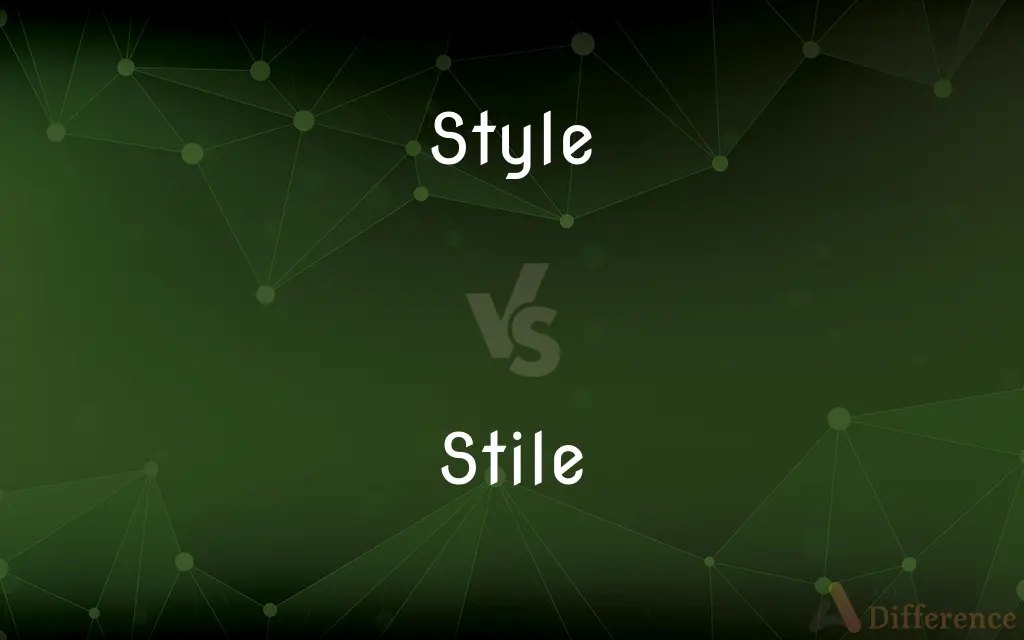Style vs. Stile — What's the Difference?
Edited by Tayyaba Rehman — By Urooj Arif — Updated on March 27, 2024
Style refers to a distinctive appearance or manner, while a stile is a structure allowing people to pass over a wall or fence.

Difference Between Style and Stile
Table of Contents
ADVERTISEMENT
Key Differences
Style encompasses the distinct appearance, design, or manner in which something is done or created. It's often used to describe the aesthetic choices in fashion, art, literature, or architecture, reflecting individuality or trends. A stile, on the other hand, is a practical construction, typically consisting of steps or a ladder, designed to help people cross over walls or fences without damaging the barrier or allowing livestock to pass through.
In terms of functionality, style serves to express personal or collective identity, taste, and creativity, influencing how objects, clothing, or spaces are perceived. Whereas a stile has a specific utilitarian function, enabling pedestrians to move from one side of a barrier to another, its design considerations focus on practicality and safety rather than aesthetics.
The concept of style is broad and can apply to multiple domains including writing, where it refers to the choice of words and syntax, or in lifestyle, signifying a way of living. Stiles are primarily found in rural or semi-rural environments, often integrated into hiking trails, farms, or public pathways to facilitate access while maintaining enclosure boundaries.
Culturally, style plays a significant role in defining eras, movements, and societal values, serving as a medium for expression and communication. Stiles, though less culturally significant, reflect the relationship between human pathways and land use, highlighting the need for accessibility in preserved or private landscapes.
The diversity in styles, whether in fashion, art, or architecture, allows for endless creativity and personal expression, continually evolving with time and societal changes. Stiles, by contrast, remain relatively unchanged in function and design, symbolizing a timeless solution to a common challenge in landscape navigation.
ADVERTISEMENT
Comparison Chart
Definition
A distinctive appearance or manner.
A structure for crossing over walls/fences.
Functionality
Expresses identity, taste, creativity.
Allows passage without damaging barriers.
Application Domain
Fashion, art, literature, architecture.
Rural or semi-rural outdoor environments.
Cultural Significance
Defines eras, movements, values.
Reflects human-land use relationship.
Evolution
Continually evolving with societal changes.
Remains unchanged, focused on practicality.
Compare with Definitions
Style
A distinctive manner of expression in writing, speech, or art.
Her writing style is known for its clarity and brevity.
Stile
A set of steps or a ladder allowing individuals to climb over a wall or fence.
We used the stile to cross the fence into the meadow.
Style
The overall appearance or design of an object, person, or place that makes it recognizable.
The smartphone’s sleek style made it immediately popular.
Stile
A simple yet effective solution for maintaining boundaries while ensuring accessibility.
Installing a stile was the perfect compromise for both the hikers and the landowners.
Style
The manner in which clothing or hairstyles are worn, often reflecting a particular era or community.
The fashion show highlighted the evolving style of the 1960s.
Stile
Often found in rural settings to facilitate public footpaths through private land.
The hiking trail includes several stiles to aid in crossing farm boundaries.
Style
A classification within an artistic or literary movement.
His paintings belong to the Abstract Expressionist style.
Stile
A traditional element in countryside landscapes, sometimes made from local materials.
The old wooden stile, covered in moss, blended perfectly with the surrounding countryside.
Style
A way of doing something, especially in terms of design or production.
The architect’s style emphasizes sustainability and natural light.
Stile
A structure designed to provide access over obstacles without allowing livestock to escape.
The stile at the edge of the field keeps the sheep from wandering off.
Style
A particular procedure by which something is done; a manner or way
Different styles of management
Stile
A stile is a structure or opening that provides people passage over or through a boundary via steps, ladders, or narrow gaps. Stiles are often built in rural areas along footpaths, fences, walls, or hedges that enclose animals, allowing people to move freely.
Style
A distinctive appearance, typically determined by the principles according to which something is designed
The pillars are no exception to the general style
Stile
An arrangement of steps that allows people but not animals to climb over a fence or wall.
Style
Fashionable elegance and sophistication
The world-famous hotel attracts guests because of its style and taste
Stile
A vertical piece in the frame of a panelled door or sash window.
Style
(in a flower) a narrow, typically elongated extension of the ovary, bearing the stigma.
Stile
A set or series of steps for crossing a fence or wall, usually constructed so as to allow humans but not livestock to pass.
Style
(in an invertebrate) a small, slender pointed appendage; a stylet.
Stile
A turnstile.
Style
Archaic term for stylus (sense 2)
Stile
A vertical member of a panel or frame, as in a door or window sash.
Style
Design or make in a particular form
The yacht is well proportioned and conservatively styled
Stile
A set of one or more steps surmounting a fence or wall, or a narrow gate or contrived passage through a fence or wall, which in either case allows people but not livestock to pass.
Style
Designate with a particular name, description, or title
The official is styled principal and vice chancellor of the university
Stile
A vertical component of a frame or panel, such as that of a door, window, or ladder.
Style
The way in which something is said, done, expressed, or performed
A style of teaching.
Stile
Obsolete form of style
Style
The combination of distinctive features of literary or artistic expression, execution, or performance characterizing a particular person, group, school, or era.
Stile
Obsolete form of style
Style
Sort; type
A style of furniture.
Stile
A pin set on the face of a dial, to cast a shadow; a style. See Style.
Style
A quality of imagination and individuality expressed in one's actions and tastes
Does things with style.
Stile
Mode of composition. See Style.
May I not write in such a stile as this?
Style
A comfortable and elegant mode of existence
Living in style.
Stile
A step, or set of steps, for ascending and descending, in passing a fence or wall.
There comes my master . . . over the stile, this way.
Over this stile in the way to Doubting Castle.
Style
A mode of living
The style of the very rich.
Stile
One of the upright pieces in a frame; one of the primary members of a frame, into which the secondary members are mortised.
Style
The fashion of the moment, especially of dress; vogue
Clothes that are in style.
Stile
An upright that is a member in a door or window frame
Style
A particular fashion
The style of the 1920s.
Style
A customary manner of presenting printed material, including usage, punctuation, spelling, typography, and arrangement
A manual of style.
Style
A name or title
Businesses under the style of Wilson and Webber.
Style
An implement used for etching or engraving.
Style
A slender pointed writing instrument used by the ancients on wax tablets.
Style
The needle of a phonograph.
Style
The gnomon of a sundial.
Style
(Botany) The usually slender part of a pistil, connecting the ovary and the stigma.
Style
(Zoology) A slender, tubular, or bristlelike process
A cartilaginous style.
Style
(Medicine) A surgical probing instrument; a stylet.
Style
(Obsolete) A pen.
Style
To design or fashion in a certain way
Styled the new model after the classic sports cars.
Style
To arrange (hair) in a certain way, as by cutting, coloring, or curling.
Style
To call or name; designate
George VI styled his brother Duke of Windsor.
Style
To make consistent with rules of style
Style a manuscript.
Style
Senses relating to a thin, pointed object.
Style
(historical) A sharp stick used for writing on clay tablets or other surfaces; a stylus; an instrument used to write with ink; a pen.
Style
A tool with a sharp point used in engraving; a burin, a graver, a stylet, a stylus.
Style
The gnomon or pin of a sundial, the shadow of which indicates the hour.
Style
(botany) The stalk that connects the stigma(s) to the ovary in a pistil of a flower.
Style
(surgery) A kind of surgical instrument with a blunt point, used for exploration.
Style
(zoology) A small, thin, pointed body part.
Style
(by extension from sense 1.1) A particular manner of expression in writing or speech, especially one regarded as good.
Style
A legal or traditional term or formula of words used to address or refer to a person, especially a monarch or a person holding a post or having a title.
Monarchs are often addressed with the style of Majesty.
Style
A particular manner of creating, doing, or presenting something, especially a work of architecture or art.
Style
A particular manner of acting or behaving; (specifically) one regarded as fashionable or skilful; flair, grace.
As a dancer, he has a lot of style.
Backstabbing people is not my style.
Style
A particular way in which one grooms, adorns, dresses, or carries oneself; (specifically) a way thought to be attractive or fashionable.
Style
(computing) A visual or other modification to text or other elements of a document, such as boldface or italics.
Applying styles to text in a wordprocessor
Cascading Style Sheets
Style
A set of rules regarding the presentation of text (spelling, typography, the citation of references, etc.) and illustrations that is applied by a publisher to the works it produces.
The house style of the journal
Style
(transitive) To design, fashion, make, or arrange in a certain way or form (style)
Style
To call or give a name or title to.
Style
To create for, or give to, someone a style, fashion, or image, particularly one which is regarded as attractive, tasteful, or trendy.
Style
To act in a way which seeks to show that one possesses style.
Style
An instrument used by the ancients in writing on tablets covered with wax, having one of its ends sharp, and the other blunt, and somewhat expanded, for the purpose of making erasures by smoothing the wax.
Style
Hence, anything resembling the ancient style in shape or use.
Style
A pen; an author's pen.
Style
Mode of expressing thought in language, whether oral or written; especially, such use of language in the expression of thought as exhibits the spirit and faculty of an artist; choice or arrangement of words in discourse; rhetorical expression.
High style, as when that men to kinges write.
Style is the dress of thoughts.
Proper words in proper places make the true definition of style.
It is style alone by which posterity will judge of a great work.
Style
A sharp-pointed tool used in engraving; a graver.
Style
Mode of presentation, especially in music or any of the fine arts; a characteristic of peculiar mode of developing in idea or accomplishing a result.
The ornamental style also possesses its own peculiar merit.
Style
A kind of blunt-pointed surgical instrument.
Style
Conformity to a recognized standard; manner which is deemed elegant and appropriate, especially in social demeanor; fashion.
According to the usual style of dedications.
Style
A long, slender, bristlelike process, as the anal styles of insects.
Style
Mode or phrase by which anything is formally designated; the title; the official designation of any important body; mode of address; as, the style of Majesty.
One style to a gracious benefactor, another to a proud, insulting foe.
Style
The pin, or gnomon, of a dial, the shadow of which indicates the hour. See Gnomon.
Style
A mode of reckoning time, with regard to the Julian and Gregorian calendars.
Style
The elongated part of a pistil between the ovary and the stigma. See Illust. of Stamen, and of Pistil.
Style
To entitle; to term, name, or call; to denominate.
How well his worth and brave adventures styled.
Style
A particular kind (as to appearance);
This style of shoe is in demand
Style
How something is done or how it happens;
Her dignified manner
His rapid manner of talking
Their nomadic mode of existence
In the characteristic New York style
A lonely way of life
In an abrasive fashion
Style
A way of expressing something (in language or art or music etc.) that is characteristic of a particular person or group of people or period;
All the reporters were expected to adopt the style of the newspaper
Style
Distinctive and stylish elegance;
He wooed her with the confident dash of a cavalry officer
Style
The popular taste at a given time;
Leather is the latest vogue
He followed current trends
The 1920s had a style of their own
Style
(botany) the narrow elongated part of the pistil between the ovary and the stigma
Style
Editorial directions to be followed in spelling and punctuation and capitalization and typographical display
Style
A pointed tool for writing or drawing or engraving;
He drew the design on the stencil with a steel stylus
Style
A slender bristlelike or tubular process;
A cartilaginous style
Style
Designate by an identifying term;
They styled their nation `The Confederate States'
Style
Make consistent with a certain fashion or style;
Style my hair
Style the dress
Style
Make consistent with certain rules of style;
Style a manuscript
Common Curiosities
Are stiles only used in rural areas?
Primarily, yes, stiles are used in rural or semi-rural areas to provide access over barriers without compromising the integrity of fences or walls.
How can style change over time?
Style evolves with societal changes, technological advancements, and cultural shifts, reflecting current trends and preferences.
Can the design of a stile be considered stylish?
While stiles are built for functionality, their design can incorporate elements of style, especially when using traditional or aesthetically pleasing materials.
What defines a person's style?
A person's style is defined by their distinctive choices in clothing, accessories, and overall appearance, reflecting their personality and preferences.
How does style impact society?
Style impacts society by influencing cultural trends, societal values, and individual identity, serving as a form of expression and communication.
What is the purpose of a stile?
The purpose of a stile is to allow people to pass over or through barriers such as fences or walls without damaging them or allowing livestock to escape.
Is style important in professional settings?
Yes, style can be important in professional settings, as it contributes to personal branding and can influence perceptions of professionalism and credibility.
Can style be taught?
While certain aspects of style can be learned, such as fashion trends or design principles, personal style is often a reflection of individual taste and creativity.
How does style influence fashion?
Style greatly influences fashion by dictating trends, shaping the fashion industry's direction, and reflecting societal attitudes and values.
How do stiles contribute to outdoor accessibility?
Stiles improve outdoor accessibility by allowing hikers and walkers to navigate through enclosed lands or obstacles, promoting outdoor activities and respect for private property.
Are there different types of stiles?
Yes, there are different types of stiles, including step stiles, ladder stiles, and kissing gates, each designed for specific types of barriers and accessibility needs.
Why are stiles important in preserving natural landscapes?
Stiles are important for preserving natural landscapes by providing access without the need to remove physical barriers, thus maintaining the integrity of the landscape and protecting wildlife habitats.
Can style affect one's mood and confidence?
Yes, style can significantly affect one's mood and confidence, as feeling good about one's appearance can boost self-esteem and positivity.
How does one develop a personal style?
Developing a personal style involves exploring different aesthetics, experimenting with trends, and ultimately choosing what best expresses one's identity and preferences.
What materials are used to make stiles?
Stiles can be made from a variety of materials, including wood, metal, and stone, depending on their location and intended aesthetic.
Share Your Discovery

Previous Comparison
Cigarette vs. Rollie
Next Comparison
Appendix vs. AnnexAuthor Spotlight
Written by
Urooj ArifUrooj is a skilled content writer at Ask Difference, known for her exceptional ability to simplify complex topics into engaging and informative content. With a passion for research and a flair for clear, concise writing, she consistently delivers articles that resonate with our diverse audience.
Edited by
Tayyaba RehmanTayyaba Rehman is a distinguished writer, currently serving as a primary contributor to askdifference.com. As a researcher in semantics and etymology, Tayyaba's passion for the complexity of languages and their distinctions has found a perfect home on the platform. Tayyaba delves into the intricacies of language, distinguishing between commonly confused words and phrases, thereby providing clarity for readers worldwide.
















































